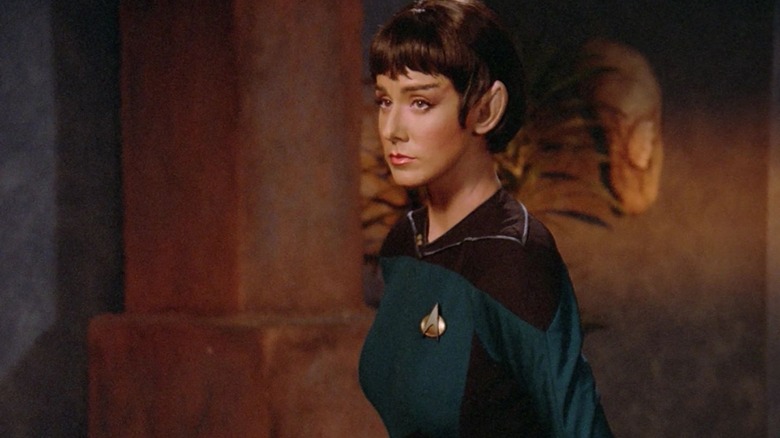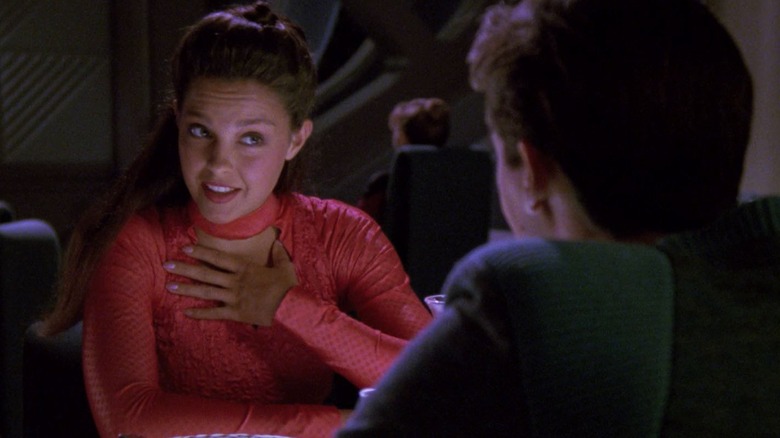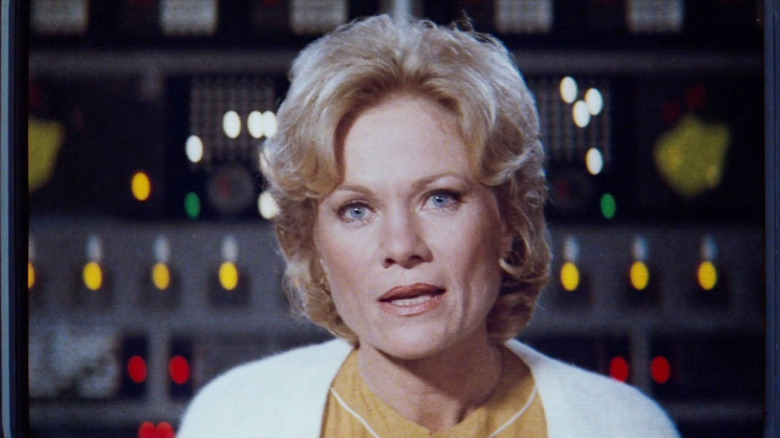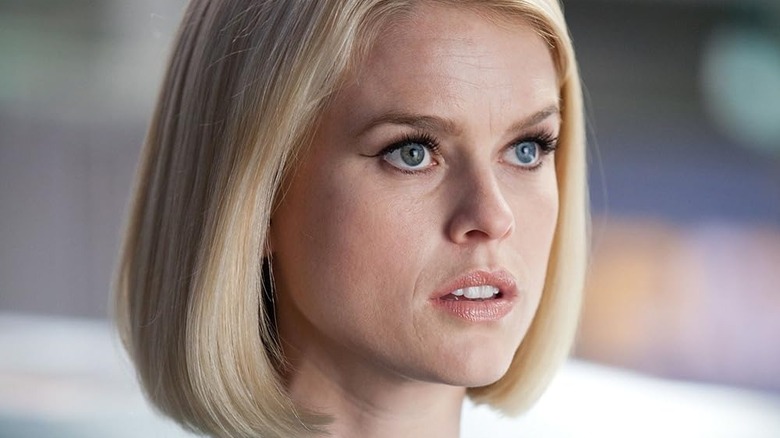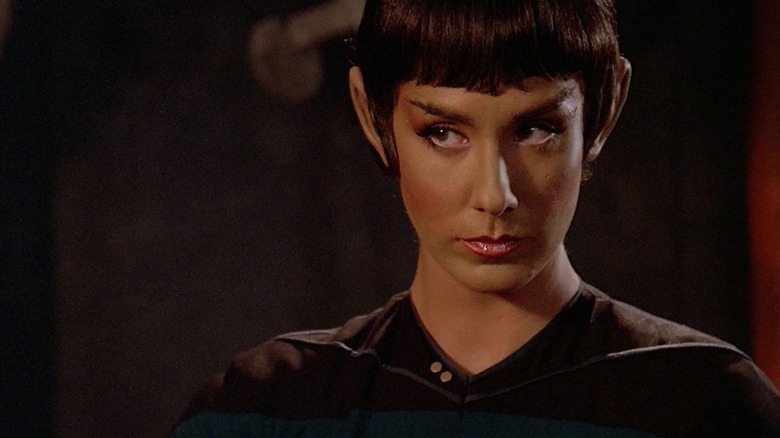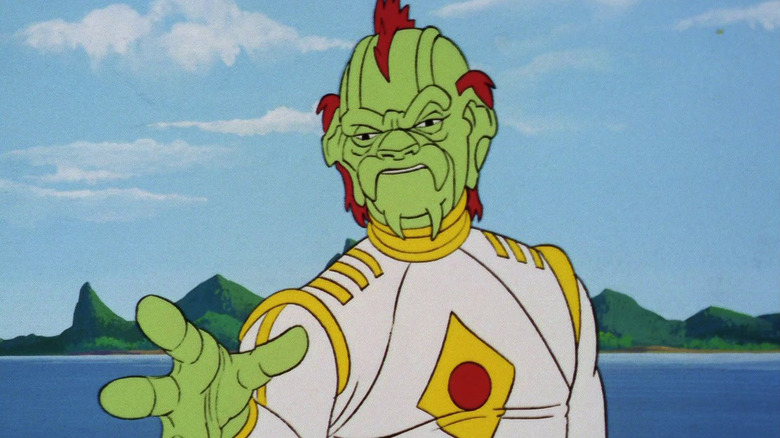5 Star Trek Characters Who Disappeared Without Any Reason
We may receive a commission on purchases made from links.
The "Star Trek" universe is vast and complicated. Most of the "Star Trek" shows to date take place on Federation vessels or stations staffed by career officers on specific assignments. The franchise largely revolves around managerial professionalism and workplace propriety. There is respect for the chain of command, and orders are given and followed as a matter of course. Starfleet is a military organization, but with its militant strictness devoted to exploration and diplomacy rather than combat and conquest. Ships are assigned to distant areas of space where they are tasked with examining a curious pulsar or, say, to a disease-ridden world in need of medicine. The bureaucracy works in "Star Trek," and individuals go where they are needed.
As such, when a minor character appears on "Star Trek," Trekkies assume that they merely arrived on the U.S.S. Enterprise (or Deep Space Nine, etc.) because they were needed there. An itinerant expert may be called in to complete a specific mission and then, once completed, they will merrily fly off to another. We understand that any character on "Star Trek" could be reassigned at any minute. So, when a minor character vanishes, it's safe to assume they experienced a career shift. Central characters only tend to stick around because a starship captain has assembled a senior staff they prefer ... and also because the actors involved in bringing them to life have signed long-term contracts.
But for those of us who like those supporting characters, a small word of explanation would have been nice. "She was transferred" is all that's really required. Below are five "Star Trek" characters that left a mark on the franchise, only to disappear without notice.
(Side note: Certain characters disappeared from the "Star Trek" franchise — from Yeoman Rand (Grace Lee Whitney) to Ensign Sonya Gomez (Lycia Naff) — only to re-emerge many years later. Those characters will be absent from this list.)
Robin Lefler
Ensign Robin Lefler was one of the first roles played by Ashley Judd, and the character only appeared in the episodes "Darmok" (September 30, 1991) and "The Game" (October 28, 1991). More than a background engineer, however, Lefler was a well-rounded, confident, even somewhat sassy character. She had little to do in "Darmok," but Lefler played a major role in "The Game," serving as a counterpart and ally to the visiting Wesley Crusher (Wil Wheaton). In "The Game," the entire crew of the Enterprise-D become addicted to a head-mounted, thought-controlled video game that gives them addictive hits of endorphins. Wesley, ever the nerd, refuses to try it, feeling its tranquilizing effect might be dangerous. He and Lefler test the game in a lab and find that it can alter a user's brain chemistry to make them more suggestible.
Robin Lefler was described as a mission specialist, and she was introduced in "The Game" dictating a numerical list of rules to live by. She explains that she has compiled a list of 102 axioms she calls Lefler's Laws and uses them as a guide to traverse life more easily. Ultimately, though, audiences only got to learn a few of the laws before the end of "The Game," although she did give a hard copy of them to Wesley as a souvenir. The two young officers parted with a solid friendship.
Sadly, that was the last anyone heard from Robin Lefler in the central "Star Trek" canon, although she would later reemerge in multiple non-canonical "Star Trek" novels, including in the novelization of "All Good Things...," the "Next Generation" finale. She also was one of the main characters in "Star Trek: New Frontier" by Peter David, a novel series that was envisioned as a fully-formed "Star Trek" spinoff set at the same time as "Next Generation" on a ship called the U.S.S. Excalibur. (Lefler was the director of operations on the Excalibur.)
Dr. Carol Marcus in Star Trek II: The Wrath of Khan
In "Star Trek II: The Wrath of Khan," Dr. Carol Marcus (played by Bibi Besch) was the inventor of the Genesis Wave, a specialize type of radiation that, when properly wielded, could terraform an entire planet in an instant, reconstituting the entire surface of a dead world into a verdant biome. She was also an old lover of Captain Kirk (William Shatner) and had been raising their son together without Kirk's knowledge. "Khan" is very much about how Kirk never actually faced the consequences of some of his more cavalier, youthful actions, and Dr. Marcus was there to remind him of the loves he left behind. Kirk and Dr. Marcus seem to reconcile by the end of the film and Kirk moves forward, knowing he'll have to communicate with his adult son David (Merritt Butrick).
David returns for "Star Trek III: The Search for Spock," but Dr. Marcus is curiously absent. Where did she go? Is Kirk content to lose contact again? It seems odd that she's never brought up again.
Dr. Carol Marcus in Star Trek Into Darkness
Strangely enough, Dr. Marcus vanishes after a single film in both the original and rebooted (aka Kelvin) timelines in the "Star Trek" franchise. In "Star Trek Into Darkness," Dr. Marcus (Alice Eve) was a weapons expert on board the Enterprise with a secret plan of her own; it seems that she is related to the wicked Admiral Alexander Marcus (Peter Weller) and initially boarded the ship under a pseudonym. Carol and Kirk (Chris Pine) go on to flirt a little before she joins the crew of the Enterprise at the end of the film.
It's weird, then, that she isn't even mentioned in "Star Trek Beyond," the sequel to "Into Darkness." Simon Pegg, who both co-wrote and starred in both of those films as the Enterprise's beloved chief engineer Montgomery "Scotty" Scott, has admitted that he simply couldn't think of anything for Carol to do.
Dr. Selar
Dr. Selar (Susie Plakson) only appeared in a few scenes of the "Next Generation" episode "The Schizoid Man" (January 23, 1989), but she intrigued Trekkies everywhere. When "Next Generation" began, creator Gene Roddenberry wanted it to be deliberately unique from the original "Star Trek" and eschewed the presence of Vulcans on the bridge, feeling the species had been well explored already. Selar was one of the first Vulcans seen serving on the Enterprise-D, so Trekkies were naturally curious to learn more about her. It also helped that she was played by Plakson, who is a massively charismatic screen presence; even without moving much, Plakson gave Selar a great deal of character.
Selar is mentioned multiple times throughout "Next Generation," implying that she plays a vital role in the Enterprise's functions. Dr. Crusher (Gates McFadden) often casually mentions that Selar's off-screen running a spectral analysis or providing valuable consultations, although she never actually reappeared on screen. At least Trekkies got to see the return of Plakson, as she played the half-Klingon ambassador K'Ehleyr in two episodes of "Next Generation," a Q in "Star Trek: Voyager," and an Andorian in "Star Trek: Enterprise." Plakson knocked it out of the park each time.
Selar was given a full-blown subplot in A.C. Crispin's novel "Eyes of the Beholders." Also, like Robin Lefler, Selar was eventually reassigned to the U.S.S. Excalibur in the "New Frontier" book series. She served as that ship's chief medical officer. Author Peter David was very good about gathering together all the supporting players that Trekkies liked.
Ari bn Bem
Many episodes of "Star Trek" featured notable guest stars who were only ever designed to appear once. For these episodes, the personal dramas of the main cast would temporarily take a backseat so that audiences (and relieved writers) could explore a new perspective. Often the guest star would either have a mystery of their own that the main cast would solve or they would have an agenda — sometimes heroic, sometime villainous — that they eventually revealed. Then, once the mystery was solved, the guest would move on, either happy to begin a new assignment or unhappily thrown in the brig. The really interesting guests would return in later episodes.
Bem (James Doohan) was a fascinatingly strange character that, one might assume, the makers of "Star Trek: The Animated Series" would want to revisit again and again, largely because he was only capable of being realized in animation. Bem was sent to the Enterprise to secretly observe the ship's crew and determine if they were ready to engage in contact with his species. He spoke in a broken fashion and seemed to know something Captain Kirk (William Shatner) didn't. Eventually, Bem's secret was revealed: he is a colony being. That is, individual parts of his body can detach and hover through the air. His legs can walk on their own and his head can be knocked from his shoulders.
The concept is strange, even for "Star Trek," but exploring Bem's biological oddities was never completed. Bem completed his mission, but the Enterprise never stayed in contact. Trekkies wouldn't see another member of Bem's species until "Star Trek: Lower Decks" 50 years later.
Bem wasn't super-important to the Enterprise and his story concluded, yet his disappearance is upsetting to me personally, as I would have loved to see him persist as a supporting player. The weirder the aliens are, the better.
